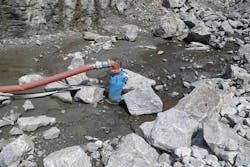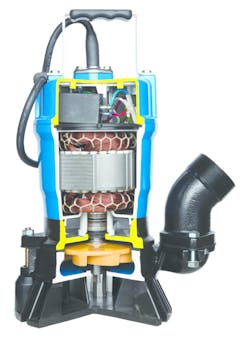A reliable electric submersible pump is a necessity in any application. Regardless of the application, a pump faces an extreme number of variables during operation that can lead to its failure. It is impossible to predict what might cause a unit to fail on the job, but by taking a proper inventory of the factors that go into making a reliable pump, those challenges can be minimized.
Points of entry
For a pump to meet the most basic standards of reliability, it has to adequately defend the two areas most susceptible to failure: the lower mechanical seal and the cable inlet. These points are considered the weakest links on any piece of pumping equipment, and if they take on water, operation ceases. It is necessary for any manufacturer to take a serious look at these weak points and defend them to the best of their abilities. And those that do reap the benefits of having a reputation for reliability.
Mechanical seal
The mechanical seal is one of the most important design aspects of a dependable pump. If a pump’s first job is to move fluid, its second job is to keep that fluid out of the motor housing at all costs, and a well-made mechanical seal makes all the difference. Seal material can vary based on the pump’s intended use, but silicon carbide is a popular choice among manufacturers since its uniform hardness and high density makes it extremely abrasion-resistant. It also boasts high thermal conductivity, high tensile strength and low thermal expansion. Depending on the application, ceramic or tungsten carbide also make for reliable seals, though the latter can fall prey to heat checking.
The innards of a reliable submersible pump must be crafted with durable materials and proven manufacturing methods. This rings especially true when considering the two most vulnerable points of entry: the mechanical seal and cable inlet.
Some manufacturers take extra steps in the design process to ensure the mechanical seal integrity lasts throughout the pump’s life cycle. For example, a lip seal can be mounted in a chamber below the bottom seal faces as a safeguard against abrasive particles, which are expelled back into the flow of liquid during operation. An oil lifter — consisting of a cylindrical seal cage — can also be implemented inside the pump’s oil chamber to provide positive lubrication to the upper and lower seal faces at all times, turning wasted energy into added protection and increased life expectancy. It is a worthwhile fix that can extend the life of any pump, regardless of application.
Cable inlet
The pumping industry is one that embraces tradition more than many; if a product’s design is sound and proven, many manufacturers will not change it for the sake of perceived progress. This can be a good practice in the interest of producing a reliable electric submersible pump, and no pump component benefits from tried-and-true manufacturing processes quite like the cable inlet.
As a prime area for potential water intrusion, the cable inlet demands attention. Often the best way to keep this point safe is by looking back to manufacturing methods that have worked for decades, such as an antiwicking block. By stripping back each conductor and sealing it with molded rubber or epoxy potting, wicking along the strand of the conductor is prevented, further enhancing pump reliability. Some may call this method archaic or expensive, but its efficacy is well-proven.
Materials matter
If the two most vulnerable points of entry are adequately protected, a manufacturer can then zoom out and look at the materials used for other components. Quality materials — such as copper — can greatly enhance the reliability of an electric submersible pump. In fact, when it comes to the stator and rotor, a direct correlation exists between the amount of copper used and a component’s durability.
Copper can add to the cost and weight of a pump, but when compared with other metals, a copper stator can result in higher conductivity, more efficiency and longer motor lifetime. Likewise, rotors made with copper offer greater efficiency while using lower input power as compared with aluminum alternatives. All pumps are susceptible to failure, but the right amount of copper could mean the difference between a pump lasting three months or more than 30 years.
Metallurgical content can have a huge impact on impeller performance as well. An inferior design may include impellers made of cast iron as opposed to polyurethane, a much more resilient material when moving fluid. If iron is to be used in the impellers, high-chrome construction can go a long way in increasing reliability because the right proportion of chromium can add strength.
Test it tough
A popular mantra in the pump industry is: If a product’s design is proven, there is no reason to change it. Many manufacturers adhere to this mantra, and their pumps have the benefit of decades of use to prove their reliability in the field. But even time-worn design and top-shelf materials can fail if a unit is not properly tested before it hits the market.
Electric submersible pumps need to be tested in harsh, real-world conditions, such as an underground mine or construction site. It is too difficult to simulate the rigors of everyday applications in a lab atmosphere, where most testing takes place in static pools of clean water at a pump’s best efficiency point. The wider the variety of abrasives that can be thrown at a pump during the testing process, the better.
This problem is compounded when introducing new technology such as a redesigned seal. It is not enough to build that seal with the best materials available — it is necessary to know how that material will interact with the shaft during an application or if the unit will continue to function even while running at the improper head. In the case of a crucial application like disaster remediation, the last thing any end user needs is a pump that lacks real-world experience.
Not if, but when
Any pump can fail at any time, no matter the amount of time and resources put into building it, which is why the final measure of a reliable electric submersible pump is the response of its manufacturer. When a pump fails, a company with the right resources in place can extend the life span of the unit and minimize downtime on the job. This requires a sizeable investment in engineering expertise and customer service, but manufacturers that support a pump throughout the life cycle of an application can keep customers happy while securing a solid reputation for reliability in the marketplace.
It is important to remember that a pump is a lot like a car. It is a piece of running machinery that is designed to operate, not sit in the garage. High-quality materials and time-tested construction methods go to waste if a pump is not used constantly and responsibly. When choosing an electric submersible pump for an application, be sure to go with a manufacturer that tests the pump properly and can offer superior aftermarket support. Once all of those factors converge, a pump can truly meet the highest standards of reliability.
Glenn Wieczorek has 30 years of experience in the marketing and engineering of water transfer products. Since being appointed managing director of Tsurumi America in 2010, he has overseen a period of unprecedented growth for the company. Prior to his time in the pump industry, Wieczorek worked as an economist for the U.S. Bureau of Labor Statistics.



